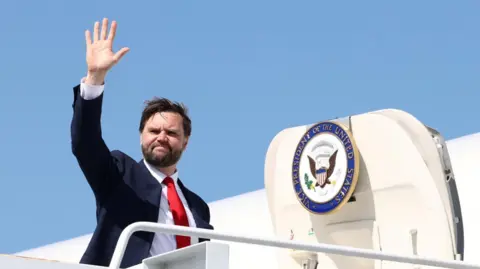US Vice-President JD Vance has recently conveyed a bleak outlook regarding the ongoing conflict in Ukraine, asserting that the war is “not going to end any time soon.” In an insightful interview with Fox News, Vance elaborated on the complexities surrounding the war, emphasizing the challenge the US administration faces in facilitating dialogue between Russia and Ukraine. According to him, the priority should be assisting both nations in discovering a “middle ground” to conclude the hostilities that have persisted for over three years.
During the discussion, Vance underscored that any potential resolution will ultimately hinge on the willingness of both Russia and Ukraine to come to a mutual agreement and bring this “brutal, brutal conflict” to a close. His statements come amid significant developments, such as Washington’s recent agreement with Kyiv, which includes sharing the profits derived from Ukraine’s rare earth mineral resources in exchange for continued American security assistance. This arrangement indicates a deeper involvement of the US in supporting Ukraine’s economy and military efforts against the ongoing Russian aggression.
In a wide-ranging conversation, Vance also defended former President Donald Trump’s approach to the war. He acknowledged the deep emotions stemming from the Ukrainian people’s anger over the invasion and raised a pivotal question: Are they willing to sacrifice countless lives over relatively minor territorial disputes? This sentiment echoes a broader debate regarding the toll of the conflict on both sides, especially as casualties continue to escalate.
Vance’s remarks mirror Trump’s recent suggestion that Ukraine might consider ceding Crimea—territory that Russia annexed in 2014—to facilitate a truce. However, this proposition was met with resistance from Ukraine’s President Volodymyr Zelensky, who reiterated that such an action would contradict the Ukrainian constitution, thereby reinforcing national sovereignty.
Complementing Vance’s interview, US Secretary of State Marco Rubio emphasized the urgency of a resolution in an appearance on the same network. He suggested that without a significant breakthrough in the conflict soon, Trump would need to reassess the amount of time and political capital he can afford to devote to Ukraine, a situation critical amid the changing dynamics of US domestic and international policy.
Adding to the urgency of the situation, Russian President Vladimir Putin declared a temporary three-day ceasefire set to commence on May 8, coinciding with celebrations marking the end of World War II. In response, Ukraine’s Foreign Minister Andrii Sybiha called for an immediate 30-day ceasefire, signaling a potential willingness to de-escalate the violence. Unfortunately, despite these diplomatic overtures, hostilities continued unabated.
In a grim illustration of the ongoing violence, a Russian drone attack on the south-eastern Ukrainian city of Zaporizhzhia on Thursday evening resulted in injuries to 14 individuals, though fortunately, there were no fatalities. Simultaneously, Moscow accused Ukraine of drone attacks targeting a market in southern Ukraine under Russian control, which led to the deaths of seven individuals and injuries to over 20. The Ukrainian government denied these claims, asserting the strikes were directed exclusively at military entities.
The situation remains dire, and as US officials like Vance, Rubio, and Zelensky navigate the complexities of international diplomacy, the prospect of peace may seem distant while hostilities escalate. The narrative surrounding the war in Ukraine continues to evolve, highlighting the challenges inherent in forging a peaceful resolution to an enduring and multifaceted conflict. In summary, the ongoing struggles reflect the consequences of geopolitical tensions while underscoring the need for urgent dialogue and ceasefires—a step vital for the lives of those caught in the crossfire.



